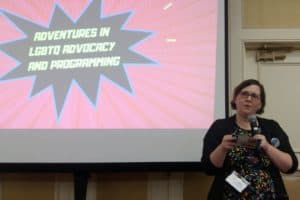
Meg Murry, the hero of Madeleine L’Engle’s A Wrinkle in Time, made an impression on young adult authors Veronica Roth and Shaun David Hutchinson.
“I read a lot of genre fiction growing up,” said Roth, creator of the Divergent series. “Fewer women were in the driving seat of those books. [But Meg] had a lot of feelings.”
Hutchinson, author of We Are the Ants (Simon Pulse, 2017) and At the Edge of the Universe (Simon Pulse, 2018), agreed. “It’s a book where being a nerd is celebrated, and that definitely bleeds into everything I write.”
Roth and Hutchinson, along with fellow bestselling YA authors Renée Ahdieh (The Wrath and the Dawn series) and Marie Lu (the Legend series), closed out the Young Adult Library Services Association’s (YALSA) Symposium in Memphis, Tennessee, on November 3 with their panel discussion, “Empowering Teens through Fantasy and Science Fiction.” The writers were candid about representation, how they build dystopian worlds, and advocating for their teen readers.
Ahdieh, whose mother is South Korean and whose father is white, remembers the first time she saw a book featuring an Asian girl on the cover. “It was incredibly formative,” she said. “I could envision my story as something worth telling.” It inspired her to write herself into her own Nancy Drew fan-fiction.
For Lu, Journey to Topaz, a book by Yoshiko Uchida about Japanese internment, has stuck with her. “I’m Chinese, not Japanese, but that was close enough.”
Hutchinson, who came out as gay in his teen years, commiserated with the concept of “close enough.”
“When you don’t have representation, you take what you can get,” he said. Added Ahdieh: “The great thing is this won’t be the case for future generations!”
Dystopia or reality?
Roth said she gets a lot of comments from concerned parents whose kids want to read about “a messed-up future” in dystopian fiction.
“I reassure them it’s not that at all,” said Roth. She views these types stories as vehicles for finding agency and hope in situations where teens may feel powerless.
Ahdieh chimed in, “[A teen on an advisory panel] said it’s the idea of burning the establishment to the ground and then being part of reestablishing that.”
“I didn’t see my stories as dystopian because we live in dystopia,” Lu joked. “High school is especially dystopian—you only get six minutes to get to your next class,” she said to audience laughter.
Still, the authors take the world-building and visualizations of their stories seriously.
“What I’m looking for are really sensory details…. Food is so important to me in books,” said Ahdieh. She also avoids overexplaining so that the reader can contribute their own point of view. “Whatever I put down, I take away half.”
Hutchinson’s process is slightly more complicated. Of writing a book set in outer space, he realized, “I’ve never been in space, I have no idea how to do this.” So he turned to virtual reality to help him better visualize his narrative.
“I taught myself how to 3D model, so I built the spaceship, I built the model. Now I’ve been building rooms on the ship instead of writing,” he laughed.
The authors also had strong feelings for critics who have complained that women or gay characters wouldn’t have agency in a particular time period, or that a certain situation in their fictional worlds wouldn’t have occurred.
“I feel like a lot of the criticism of historical romance comes from a group of people who really love to denigrate things women enjoy,” said Ahdieh. “[People ask,] ‘Would this kind of character have existed in this time?’ There’s a dragon in this book, so calm the F down!” she exclaimed to rousing applause.
“The only people who get really antsy about this are straight white dudes,” quipped Lu. Hutchinson added: “Sometimes we write about the world as it is, sometimes we write about the world we want to see.”
Teens of tomorrow
When asked how they advocate for teens, the authors were quick to shine the spotlight on them.
“I am inspired by young people, and I’m channeling it into my fiction,” said Lu. “You shouldn’t have to be out there marching for gun violence. But it makes me proud.”
Added Ahdieh: “We need to stop denigrating our youth because they are literally going to save us.” She remarked how, unlike in her childhood, a constant barrage of social pressure, consumerism, and news follows teens home. “I feel so motivated because they’re so informed—my nieces know everything,” she said.
To that end, Roth suggests that she and the other panelists might serve a purpose in providing escapism from stress. “Maybe what’s important is giving them a place to rest,” she said. “Just fostering a love of reading is very important for the future.”


